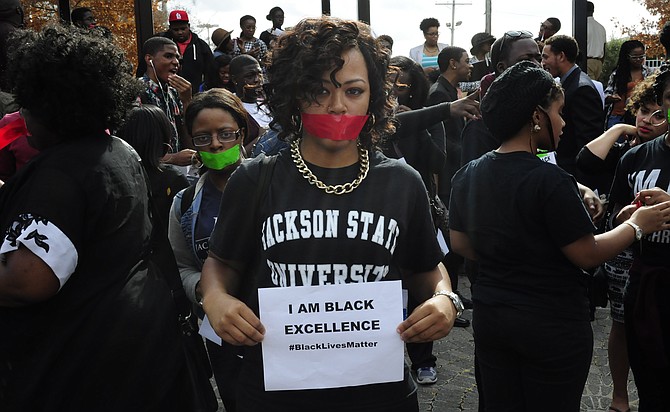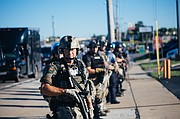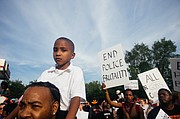On Dec. 1, Jackson State University students staged a so-called die-in at Gibbs-Green Plaza, where local police opened fire on anti-war protesters in May 1970, killing two young black men, Phillip Lafayette Gibbs and James Earl Green, and wounding 12 others. The officers involved in the shooting never faced criminal penalties. Photo by Trip Burns.
What you have to look at is what is happening in this country. And what is really happening is that brother has murdered brother knowing it was his brother. White men have lynched Negroes knowing them to be their sons. White women have had Negroes burned knowing them to be their lovers. It is not a racial problem. It's a problem whether or not you're willing to look at your life and be responsible for it and then begin to change it. That great Western house I come from is one house, and I am one of the children of that house. Simply, I am the most despised child of that house. And it is because the American people are unable to face the fact that I am, in fact, the flesh of their flesh, bone of their bone, created by them. My blood, my father's blood is in that soil. They can't face that. And that is why the city of Detroit went up in flames.
— James Baldwin, 1969
In some ways, the story of Ferguson began in the South.
Consider the case of my grandmother, Gladys Smith. Grandma GG, she is called, was born in Pine Bluff, Ark., and married my grandfather young. They raised their family of six children in north St. Louis City.
Like other Midwestern cities, St. Louis' population exploded after World War II, fueled by the Great Migration of African Americans fleeing the political and economic oppression, racial terrorism and uncertainty of the South.
One of the main characters in Isabel's Wilkerson's 2010 book "The Warmth of Other Suns," for example, left Chickasaw County, Miss., and moved to Chicago after a white mob savagely beat one of her relatives, who was falsely accused of stealing turkeys. The relative had a reputation for taking things that didn't belong to him, so the white posse who beat the man near death offered no apologies. Another character in Wilkerson's book, a black physician from Louisiana, did his medical training in St. Louis' Homer G. Phillips Hospital, which was built to serve the city's black population and was one of the few places African American doctors could work.
In St. Louis, city fathers decreed that black migrants were allowed to settle only in neighborhoods north of Delmar Avenue, which cuts the city and its imagination into halves. Today, St. Louis is one of the nation's most segregated cities, north city being code for black and south city code for white, much like our local parlance attempts to communicate about west and south Jackson and the city's northeast side.
Like the lines on a geometric plane, the demographic boundaries didn't end at the St. Louis city limits.
As the challenges of poverty and crime worsened, aided by hapless Reagan-era urban policies, black families that could afford to move out of the city migrated into north St. Louis County. The presence of well-paying multinational companies like Chrysler and Ford and defense contractor McDonnell Douglas, that had manufacturing operations in North County, was a big pull for these families.
Today, North County municipalities like Florissant and Hazelwood, located just north and west of Ferguson, remain bastions for upper-middle-class and wealthy blacks. At the same time this was happening, St. Louis was following the trend of other major American cities in demolishing (instead of fixing) its segregated, drug- and crime-plagued high-rise public housing projects. Many residents moved closer to relatives and economic opportunity in north county—frightened mothers in the North who sent troubled sons to "safety," with wise, loving grandmothers in the old Confederacy.
Some of them found apartment managers willing to accept public-housing vouchers from the federal government; new apartment complex sprouted up to accommodate the influx.
Ferguson, wedged between St. Louis City and the wealthier North County communities, is regarded as affordable and safe. So Ferguson is where my grandmother decided to retire. After decades spent working as a counselor for a social-services nonprofit, my grandmother gave up a beautiful two-story Victorian three blocks from the apartment building where my mother lived when I was born and moved to a ranch-style home in the relative peace and quiet of Ferguson.
Ferguson is the kind of city where some neighborhoods are black and some are white, but people are polite and neighborly when they pass each other on the street in Ferguson's quaint downtown business district.
My grandmother's street is the kind of place where upper-middle-aged men washed their cars and mowed their front lawns proudly and with religious devotion every Saturday afternoon, a neighborhood where children are rarely seen except when relatives visit on holidays.
Ferguson is the kind of place where, by my grandmother's recollection, she had to interact with the police just one time in the last 20 years. And it is the kind of place so humdrum that even someone like my grandmother can go two decades without realizing that this majority-black town had a white mayor, a nearly all-white city council and an overwhelmingly majority white police force.
So Aug. 8, 2014, was a wake-up call for everyone, myself included.
The March
I was supposed to be in Ferguson the day Darren Wilson killed Michael Brown. It was the week of my father's 60th birthday, an event that ordinarily means a small celebration at noon Saturday at Grandma GG's house.
My parents instead decided to go to Memphis, so we could meet halfway. If I had gone to St. Louis as originally planned, I might have been seated on her large, comfortable sofa balancing a plate of food on my lap about the time that Wilson, a Ferguson police officer, confronted Brown, who was 18, and his friend for walking in the middle of the street.
Brown was going to visit his grandmother, too. Wilson would later testify to a grand jury that it was during this confrontation that he remembered a "stealing" call that came across his radio earlier and that the description of the suspects matched Brown and his companion, Dorian Johnson.
Because Brown's body lay on the ground uncovered for more than four hours, I undoubtedly would have encountered emergency vehicles and the swelling crowd of onlookers. I likely would have stopped at the QuikTrip for a fillup and a fountain drink, which only costs $.79 in the summertime.
Instead, the news of the shooting came via my mother's iPhone during dinner at a chain steak restaurant in suburban Memphis. After the string of shootings of unarmed black teenagers, I'd trained myself not to react right away. To wait on the facts. Or maybe I have just become numb to these things.
My senses returned the following day when Ferguson erupted into chaos, and I thought of my grandmother no more than a few blocks away from where the QuikTrip gas station was engulfed in flames and the police were shooting people, many of them young folks, with rubber bullets and tear gas.
Grandma GG talks a lot about her confusion and disappointment in everyone involved. She's confused as to why Darren Wilson believed killing Mike Brown was the only way out of their confrontation. She's disappointed in the video that reportedly shows Mike Brown bullying a tiny store clerk not long before the shooting. Once, she joked aloud that instead of breaking into the small shops along West Florissant, a bolder statement would have been to bust into one of the local banks. After Bob McCullough, the St. Louis County prosecutor, drew wide criticism for bungling the investigation of Darren Wilson, my grandmother asked me whether it was legal, come November, to write in the name of the African American woman McCullough defeated in the Democratic primary earlier in the year.
And like a lot of older African Americans, she's embarrassed by the looting and how it reflects on the rest of the black community.
"It's really weird. I don't understand it. Why would you do that?" she told me after the announcement that a St. Louis County grand jury would not indict Wilson.
"You know, we live around here and those little mom-and-pop stores, people use those services. I mean, black folks got little shops and things, probably all their lives dreamed of owning a business, and this is where they got their little start."
"What's wrong with marching and walking without being destructive?" she asked me.
"Do you think they would have made their point by marching?" I asked her back.
She paused.
"Well, no."
The Battle
The meaning of Ferguson is vigorously debated and will be for the foreseeable future.
Is it a moment or a movement? A battle or war? Is its objective political control or economic empowerment? If one were to poll protesters on any given night, one would find affirmative answers to each of these questions.
At play among the Ferguson faithful is a unique kind of American individualism.
Each person who has sojourned to Ferguson to march along West Florissant and South Florissant with their hands in the air has done so for his or her own reasons. Some of those reasons have everything to do with Mike Brown and how disposable we consider black lives. Some of those reasons have little to do with Brown's death per se or the desire to prosecute Officer Wilson.
The lack of a defined objective seems to have only made Ferguson's movement stronger. Now, the Wikipedia entry for the "Shooting of Mike Brown" is longer than the entry for the city of Ferguson.
The underlying current, to paraphrase James Baldwin, is that America's political and economic arrangements have proved to be too expensive for most of America. Ferguson is teaching us that America will change its arrangements, or our arrangements will be changed for us.
One-hundred-sixteen days have passed since the worlds of Wilson, a 27-year-old white police officer, collided with the world of Brown, an African American 18-year-old who was about to start trade school, on a street in Ferguson, Mo.
One hundred fifteen days have passed since Ferguson collided with the imagination of the world.
Counting from the day after Brown's death, when the teary-eyed vigil of peaceful mourners somehow mutated into a night of vandalism, looting and tear gas, the Ferguson protests have now lasted longer than the six days of unrest in 1992 that followed the acquittal of white police officers who beat Rodney King senseless on the side of a road in Los Angeles. The Ferguson protests have lasted a third as long as the Montgomery Bus Boycott that took place between December 1955 and December 1956.
Ferguson is, so far, somewhere between L.A. and Montgomery.
At times, like we saw in Los Angeles, Ferguson protests have been marked by pure rage at the institutional arrangements in a country that gives its assent to the extrajudicial execution of black men for the most minor of legal infractions or no infraction at all. Sometimes, the rage in Ferguson has been misdirected, aimed not at the system but at a cake shop. At other times, Ferguson has had all the makings of the bus boycott, which extended to African American bus passengers the fundamental human right simply to rest after a long day at work.
What started organically in Ferguson with mad, disconnected young African American boys and girls, as a series of unorganized nightly actions, has matured over the past 100 days into a sophisticated movement. We saw the evidence of this recently after the grand jury's predictable declination to criminally indict Darren Wilson and have him stand trial. The decision sparked a new round of destructiveness and outrage in Ferguson.
The announcement also ignited demonstrations that took place the day after Thanksgiving when activists shut down three upscale shopping malls by lying down on the ground and singing anti-racism Christmas carols. All this, on the most important day for American retailers.
You have our attention.
In fact, no movement, even ones where the objectives were more clearly defined, has ever been successful without disrupting the prevailing economic arrangements. Montgomery is probably the most iconic of these disruptions in modern history. And so was L.A. That's because people who lack political power can make big statements with relatively small amounts of money.
Those who lament the economic toll of the Ferguson protests (by some estimates, the L.A. riots cost that city $4 billion), which includes the looting and property damage as well as the Black Friday demonstrations, forget that this country was born out of one of the most famous acts of vandalism in recorded human history.
What we now romanticize as the Boston Tea Party was the result of dissatisfied British subjects disguising themselves as American Indians and destroying the cargo of the East India Tea Company, one of the richest and most powerful corporations in the world.
That's not to say the tea party was right, either, but it did happen that way.
The Declaration of Independence, which codified all the grievances of the Founding Fathers against the British empire and provided the foundation for the American Revolution, itself sounds like it could have been penned by St. Louis activists.
Just replace all the instances of "British soldiers" with "Ferguson Police Department" and be crushed by the weight of what is happening in Ferguson.
It is that realization, that Ferguson is in that way a uniquely American creation, has us terrified.
There is, of course, the terror of every black man in America that they might, too, find themselves lying in the street for hours after an encounter with a peace officer. There is the understandable terror of black mothers and fathers who can no longer dismiss the deaths of the Trayvon Martins and Jordan Davises, the Edward Evanses and Quardious Thomases of the world as isolated tragedies that happen to parents who failed to raise their kids right.
In the second half of this year, Eric Garner, John Crawford, Ezell Ford and Tamir Rice, the baby of this groupat age 12, have been added to this list, along with Michael Brown.
Above all, simmering in Ferguson is a terror that people aren't going to take it any longer, that people have studied the history of this country and that history is repeating itself, and that we are helpless in knowing for sure where history will lead us.
See the JFP's full archive of Ferguson coverage here.




